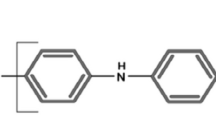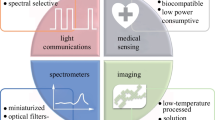Abstract
In this paper, Bi2S3 nanorods were successfully synthesized via a facile one-pot hydrothermal method and characterized by X-ray diffraction, field emission scanning electron microscopy, transmission electron microscopy and X-ray photoelectron spectroscopy. Then the Bi2S3 nanorods were deposited on Au interdigital electrodes by dip-coating to fabricate photodetectors. The photoresponse properties using Bi2S3 nanorods as a representative system showed a significantly enhanced conductivity and the current-voltage (I-V) characteristic exhibited about ca. 2 orders of magnitude larger than the dark current. The response and decay time was estimated to be ~371.66 and 386 ms, respectively, indicating Bi2S3 may be an excellent candidate for high speed and high-sensitivity photoelectrical switches and light sensitive devices.
Similar content being viewed by others
References
Chen Y C, Cao T, Chen C, Pedramrazi Z, Haberer D, de Oteyza D G, Fischer F R, Louie S G, Crommie M F. Molecular bandgap engineering of bottom-up synthesized graphene nanoribbon heterojunctions. Nature Nanotechnology, 2015, 10(2): 156–160
Rao P M, Cai L, Liu C, Cho I S, Lee C H, Weisse J M, Yang P, Zheng X. Simultaneously efficient light absorption and charge separation in WO3/BiVO4 core/shell nanowire photoanode for photoelectrochemical water oxidation. Nano Letters, 2014, 14(2): 1099–1105
Peng S, Li L, Wu H B, Madhavi S, Lou X W. Controlled growth of NiMoO4 nanosheet and nanorod arrays on various conductive substrates as advanced electrodes for asymmetric supercapacitors. Advanced Energy Materials, 2015, 5(2): 1401172
Tan C, Qi X, Huang X, Yang J, Zheng B, An Z, Chen R, Wei J, Tang B Z, Huang W, Zhang H. Single-layer transition metal dichalcogenide nanosheet-assisted assembly of aggregation-induced emission molecules to form organic nanosheets with enhanced fluorescence. Advanced Materials, 2014, 26(11): 1735–1739
Huang X, Yu H, Chen J, Lu Z, Yazami R, Hng H H. Ultrahigh rate capabilities of lithium-ion batteries from 3D ordered hierarchically porous electrodes with entrapped active nanoparticles configuration. Advanced Materials, 2014, 26(8): 1296–1303
Giri A K, Pal P, Ananthakumar R, Jayachandran M, Mahanty S, Panda A B. 3D hierarchically assembled porous wrinkled-paper-like structure of ZnCo2O4 and Co-ZnOai]C as anode materials for lithium-ion batteries. Crystal Growth & Design, 2014, 14(7): 3352–3359
Cheng C, Ren W, Zhang H. 3D TiO2/SnO2 hierarchically branched nanowires on transparent FTO substrate as photoanode for efficient water splitting. Nano Energy, 2014, 5: 132–138
Choy J H, Jang E S, Won J H, Chung J H, Jang D J, Kim Y W. Soft solution route to directionally grown ZnOnanorodarrays on Si wafer; room-temperature ultraviolet laser. Advanced Materials, 2003, 15(22): 1911–1914
Huang H, Pan L, Lim C K, Gong H, Guo J, Tse M S, Tan O K. Hydrothermal growth of TiO2 nanorod arrays and in situ conversion to nanotube arrays for highly efficient quantum dot-sensitized solar cells. Small, 2013, 9(18): 3153–3160
Liao J Y, Lei B X, Chen H Y, Kuang D B, Su C Y. Oriented hierarchical single crystalline anatase TiO2 nanowire arrays on Tifoil substrate for efficient flexible dye-sensitized solar cells. Energy & Environmental Science, 2012, 5(2): 5750–5757
Guo W, Xu C, Wang X, Wang S H, Pan C, Lin C, Wang Z L. Rectangular bunched rutile TiO2 nanorodarrays grown on carbon fiber for dye-sensitized solar cells. Journal of the American Chemical Society, 2012, 134(9): 4437–4441
Tang Z R, Li F, Zhang Y, Fu X, Xu Y J. Composites of titanatenanotube and carbon nanotube as photocatalyst with high mineralization ratio for gas-phase degradation of volatile aromatic pollutant. Journal of Physical Chemistry C, 2011, 115(16): 7880–7886
Jiang J, Li Y, Liu J, Huang X. Building one-dimensional oxide nanostructure arrays on conductive metal substrates for lithium-ion battery anodes. Nanoscale, 2011, 3(1): 45–58
Wang Z L, Song J. Piezoelectric nanogenerators based on zinc oxide nanowire arrays. Science, 2006, 312(5771): 242–246
Martinez L, Bernechea M, de Arquer F P G, Konstantatos G. Near IR-sensitive, non-toxic, polymer/nanocrystalsolar cells employing Bi2S3 as the electron acceptor. Advanced Energy Materials, 2011, 1 (6): 1029–1035
Xiao G, Dong Q, Wang Y, Sui Y, Ning J, Liu Z, Tian W, Liu B, Zou G, Zou B. One-step solution synthesis of bismuth sulfide (Bi2S3) with various hierarchical architectures and their photoresponse properties. RSC Advances, 2012, 2(1): 234–240
Li Y, Wei F, Ma Y, Zhang H, Gao Z, Dai L, Qin G. Selected-control hydrothermal synthesis and photoresponse properties of Bi2S3micro/ nanocrystals. CryEngComm, 2013, 15(33): 6611–6616
Konstantatos G, Levina L, Tang J, Sargent E H. Sensitive solutionprocessed Bi2S3 nanocrystalline photodetectors. Nano Letters, 2008, 8(11): 4002–4006
Yao K, Gong W W, Hu Y F, Liang X L, Chen Q, Peng L M. Individual Bi2S3 nanowire-based room-temperature H2 sensor. Journal of Physical Chemistry C, 2008, 112(23): 8721–8724
Bao H, Li C M, Cui X, Gan Y, Song Q, Guo J. Synthesis of a highly ordered single-crystalline Bi2S3 nanowire array and its metal/ semiconductor/metal back-to-back Schottky diode. Small, 2008, 4 (8): 1125–1129
Ma J, Liu Z, Lian J, Duan X, Kim T, Peng P, Liu X, Chen Q, Yao G, Zheng W. Ionic liquids-assisted synthesis and electrochemical properties of Bi2S3 nanostructures. CrystEngComm, 2011, 13(8): 3072–3079
Rabin O, Manuel Perez J, Grimm J, Wojtkiewicz G, Weissleder R. An X-ray computed tomography imaging agent based on longcirculating bismuth sulphide nanoparticles. Nature Materials, 2006, 5(2): 118–122
Schricker A D, Sigman M B Jr, Korgel B A. Electrical transport, Meyer–Neldel rule and oxygen sensitivity of Bi2S3 nanowires. Nanotechnology, 2005, 16(7): S508–S513
Liao X H, Wang H, Zhu J J, Chen H Y. Preparation of Bi2S3 nanorods by microwave irradiation. Materials Research Bulletin, 2001, 36(13–14): 2339–2346
Tang C J, Wang G Z, Wang H Q, Zhang Y X, Li G H. Facile synthesis of Bi2S3 nanowire arrays. Materials Letters, 2008, 62(21–22): 3663–3665
Tang C, Wang C, Su F, Zang C, Yang Y, Zong Z, Zhang Y. Controlled synthesis of urchin-like Bi2S3 via hydrothermal method. Solid State Sciences, 2010, 12(8): 1352–1356
Lu F, Li R, Li Y, Huo N, Yang J, Li Y, Li B, Yang S, Wei Z, Li J. Improving the field-effect performance of Bi2S3 single nanowires by an asymmetric device fabrication. A European Journal of Chemical Physics and Physical Chemistry, 2015, 16(1): 99–103
Andzane J, Kunakova G, Varghese J, Holmes J D, Erts D. Photoconductive properties of Bi2S3 nanowires. Journal of Applied Physics, 2015, 117(6): 064305
Wang H, Zhu J J, Zhu JM, Chen H Y. Sonochemical method for the preparation of bismuth sulfide nanorods. Journal of Physical Chemistry B, 2002, 106(15): 3848–3854
Wei F, Zhang J, Wang L, Zhang Z K. Solvothermal growth of single-crystal bismuth sulfide nanorods using bismuth particles as source material. Crystal Growth & Design, 2006, 6(8): 1942–1944
Peng X S, Meng G W, Zhang J, Zhao L X, Wang X F, Wang Y W, Zhang L D. Electrochemical fabrication of ordered Bi2S3 nanowire arrays. Journal of Physics D, Applied Physics, 2001, 34(22): 3224–3228
Zhang B, Ye X, Hou W, Zhao Y, Xie Y. Biomolecule-assisted synthesis and electrochemical hydrogen storage of Bi2S3 flowerlike patterns with well-aligned nanorods. Journal of Physical Chemistry B, 2006, 110(18): 8978–8985
Wang Y, Chen J, Wang P, Chen L, Chen Y B, Wu L M. Syntheses, growth mechanism, and optical properties of [001] growing Bi2S3 nanorods. Journal of Physical Chemistry C, 2009, 113(36): 16009–16014
Kind H, Yan H, Messer B, Law M, Yang P. Nanowire ultraviolet photodetectors and optical switches. Advanced Materials, 2002, 14 (2): 158–160
Author information
Authors and Affiliations
Corresponding author
Additional information
Taotao Ding received the B.S. degree from School of Environmental and Chemical Engineering, Nanchang Hangkong University, China, in 2011. Now, he is working toward his Ph.D. degree in Wuhan National Laboratory for Optoelectronics, Huazhong University of Science and Technology, China. His research interests include synthesis of nano-materials and their application in sensors and energy storage.
Yu Tian is a lecturer in School of Physics and Information Engineering, Jianghan University, China. She received the B.S. degree from Physics and Electronic Science Department, Luoyang Normal University, China, in 2004; and received the M.S.-Ph.D. degrees from Materials Physics and Chemistry, Wuhan University, China, in 2010. From 2010 - 2012, she was a postdoctor in Wuhan National Laboratory for Optoelectronics, Huazhong University of Science and Technology, China. Her research interests include synthesis of ZnO nanowire and investigation of the defect in ZnO nanowire.
Jiangnan Dai is an associate professor in Wuhan National Laboratory for Optoelectronics, Huazhong University of Science and Technology, China. He received the B. S. degree from Hunan University of Science and Technology, China, in 2002; received the M.S. and Ph.D. degrees from School of Materials Science and Engineering, Nanchang University, China, in 2004 and 2007 respectively. From 2008 - 2010, he was a postdoctor in Wuhan National Laboratory for Optoelectronics, Huazhong University of Science and Technology, China. His research focuses on material growth and device fabrication of wide bandgap semiconductor (AlGaN, GaN, ZnO).
Changqing Chen is a proferssor in Wuhan National Laboratory for Optoelectronics, Huazhong University of Science and Technology, China. He received the B.S. and M. S. degrees from Wuhan University, China, in 1992 and 1994 respectively; received the Ph.D. degrees from Shanghai Institute of Metallurgy, Academy of Sciences of China, China (in 1997) and University of Erlangen- Nürnberg, German (in 2000). From 2001 - 2004, he was a research scientist in Virginia Commonwealth University and University of South Carolina. His research focuses on semiconductors materials and devices including light-emitting diodes and photodetectors.
Rights and permissions
About this article
Cite this article
Ding, T., Tian, Y., Dai, J. et al. Building one-dimensional Bi2S3 nanorods as enhanced photoresponding materials for photodetectors. Front. Optoelectron. 8, 282–288 (2015). https://doi.org/10.1007/s12200-015-0529-4
Received:
Accepted:
Published:
Issue Date:
DOI: https://doi.org/10.1007/s12200-015-0529-4




